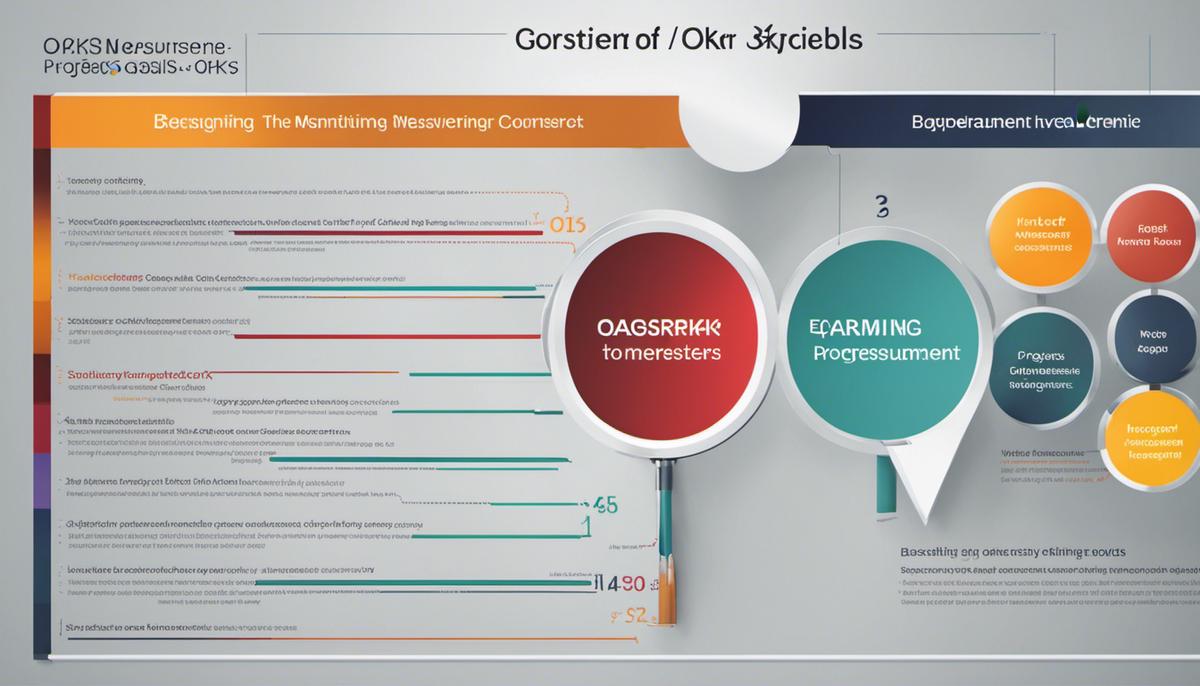As professionals in an evolving business landscape, understanding and effectively utilizing Objectives and Key Results (OKRs) can be a game-changer for leaders seeking to drive targeted growth and performance within their organizations. The development of effective OKRs, their relevant implementation, and their evaluation play a crucial role in aligning individual, team, and organizational objectives. In this discourse, we explore the essence of OKRs, their strategic creation, the mechanism behind their implementation in an organization, methodologies of monitoring and evaluating progress towards these goals, along with practical examples of leadership success stories in OKR implementation. We shall also examine the common challenges that leaders might encounter in the process and potential solutions to overcome these hurdles.
Understanding OKRs: The Basics
Understanding OKRs: The Basics
Objectives and Key Results (OKRs) is a framework that helps organizations define, track, and measure their goals. This goal-setting approach is centered around two main components: ‘Objectives’, which refer to what an organization or an individual hopes to achieve, and ‘Key Results’, which break down the objective into quantifiable measures that make progress towards the objective tangible and trackable.
The origins of OKRs date back to the 1970s, when Intel co-founder Andy Grove pioneered the concept. It later garnered attention when Google adopted the framework in its early days, attributing a considerable part of its success to this strategic approach towards goal setting.
Why OKRs Matter
OKRs are pivotal in driving alignment and engagement around measurable goals. They enable leaders to cascade their objectives downward in the organization, promoting transparency and focus. The possibility of measuring progress towards every Key Result contributes to achieving more predictable results and fosters a culture of accountability.
The benefit of using OKRs lies in their ability to strike a balance between ambitious goals (objectives) and achievable results (key results). By focusing on key results, team members understand exactly what success looks like and what steps they need to take to achieve it.
Distinction from Other Goal-Setting Techniques
While there are many goal-setting frameworks out there such as Balanced Scorecard and SMART goals, OKRs set themselves apart in several ways. Unlike traditional goal-setting techniques, OKRs encourage ambitions that surpass the comfort zone. As popularized by Google, a 70% achievement rate in OKRs is often considered a success, promoting a culture of calculated risk and innovation.
Moreover, OKRs are not meant to be a once-a-year activity. Most organizations that adopt OKRs operate on a quarterly cycle, enabling them to adapt quickly to changing business needs and market trends.
Leadership and the Importance of OKRs
OKRs, or Objectives and Key Results, provide more than just a framework for outlining and communicating objectives in leadership. They serve as the cornerstone for aligning various initiatives, providing each member of the team with a clear path to follow, as well as enforcing accountability. By flowing OKRs from the upper echelons of leadership down to each team member, a unified strategic direction is ensured.
Leaders also leverage OKRs as a tool to embolden their team members. Letting them craft their own OKRs encourages a sense of ownership and dedication. Regular OKR progress check-ins further bolster engagement, reinforce transparency, and enable necessary course corrections.
In conclusion, leaders can effectively utilize the OKR model to enhance their team’s performance, foster collaboration and stimulate innovation across their organizations.

How Leaders Set Effective OKRs
The Art of Formulating Effective OKRs
Objective and Key Results (OKRs) embody a powerful goal-setting discipline that leaders employ to harmonize individual, team, and wider organizational objectives. The implementation of OKRs serves a many-fold purpose – it offers a clear vision of what constitutes success, stirs a shared sense of purpose and cultivates alignment throughout the organization. OKRs equip employees with the understanding of their role, connects their contribution to the overall organizational success, and supplies quantifiable criteria for performance appraisal.
SMART Criteria in OKRs
To enhance the effectiveness of OKRs, leaders integrate the SMART framework – Specific, Measurable, Achievable, Relevant, and Time-bound objectives. A specific OKR articulates a clear, simple, and precise objective. It reduces ambiguity and gives a clear path to success. A measurable OKR establishes quantitative or qualitative standards to evaluate progress and outcomes. Achievable OKRs foster motivation by setting targets that are challenging, yet attainable. Relevant OKRs align with the individual, team, and organizational strategic imperatives. Time-bound OKRs ensure there is a deadline for achieving the objectives, creating a sense of urgency and focus on tasks that matter.
Aligning Individual, Team and Organizational OKRs
Successful leaders understand the importance of vertical alignment in OKRs – aligning individual and team OKRs with overarching organizational goals. This linkage requires a clear understanding and articulation of the organization’s strategic targets. Once these are set, teams create their OKRs that will contribute to achieving these company-level objectives. Individuals then craft their OKRs in a manner that feeds directly into their team’s OKRs. This cascading process of setting OKRs ensures that everyone is moving in the same strategic direction.
Involving Everyone in OKR Setting Process
Leaders foster ownership and commitment to OKRs by inviting individuals and teams to contribute to their construction. Instead of cascading objectives down the organizational hierarchy, they encourage bottom-up proposals, fostering initiative and innovation. This process supports collaboration, open communication, and trust-building, which significantly enhance the chances of achieving OKRs. Moreover, regular OKR revision and check-ins keep everyone accountable and informed about progress, fostering dynamic alignment in the ever-changing business environment.
Effective Communication of OKRs
Leaders ensure successful OKR implementation through clear and frequent communication. They use a variety of channels such as meetings, team huddles, email updates, and company-wide presentations to continuously clarify OKRs and discuss progress. The visibility into both organizational and individual OKRs ensures everyone is aware of the company’s strategic direction and their role in achieving it, fostering a shared sense of purpose that enhances productivity and morale.
Cultivating an OKR-Supportive Culture
To implement OKRs (Objectives and Key Results) effectively, it is essential to develop a culture that nurtures their accomplishment. Successful leaders foster a culture entrenched in transparency, collaboration, and continuous learning. By celebrating success, promoting risk-taking, and reframing failures as opportunities for learning, leaders create an environment where teams and individuals are encouraged to aim high. This atmosphere is pivotal for proposing ambitious OKRs, driving growth, and facilitating continual progression.

Implementing OKRs in an Organization
Establishing Clear Expectations with OKRs
The role of leaders in leveraging OKRs is central to the functioning of an organization as they set precise and quantifiable expectations. Leaders lay out the strategic vision of the organization and then translate it into specific, measurable objectives. In this process, leaders and teams work collaboratively to ensure shared understanding of goals.
OKRs are used by leaders as a tool to communicate their expectations unambiguously, thereby aligning all members of the organization towards the attainment of specific and measurable outcomes. This approach facilitates understanding, minimizes ambiguity, and promotes collective commitment towards common goals.
Promoting Transparency in OKR Implementation
Transparency is an elemental principle in adopting the OKR framework. Leaders can use OKRs to facilitate an open communication paradigm, where every team member has full insight into the organization’s high-level goals and objectives. Leaders need to ensure that OKRs are not just transparent but also accessible to all, which is crucial to make everyone feel part of the process.
This transparent culture encourages employees to see the bigger picture, understand how their individual contribution drives the overarching strategy, and gives them an insight into decision-making processes.
Building a Culture that Embraces OKR Methodology
Change is often met with resistance, and implementing the OKR methodology is no exception. Leaders are instrumental in creating and fostering a culture that embraces the OKR model. To create a successful shift, leaders should demonstrate the benefits of OKRs through their actions, showing commitment to the process and modeling the behaviors they want their teams to emulate.
A culture that embraces the OKR methodology is one where mistakes are seen as learning opportunities, progress is celebrated, and feedback is not only accepted but actively encouraged.
Leaders’ Crucial Role in OKR Execution
Leaders are essential for the successful implementation of the OKR methodology because they set the strategic direction, measure progress, encourage transparency, and foster an OKR-friendly culture. Without skilled leadership, the effectiveness of this methodology could be significantly compromised.
Leaders deploy OKRs to ensure team alignment and motivate individuals, creating a clear focus on essential goals. They also foster collaboration and cultivate a sense of ownership and accountability amongst team members. Additionally, leaders are fundamental in reviewing and recalibrating OKRs to ensure they remain pertinent and achievable amid evolving business landscapes.

Monitoring and Evaluating OKRs
The Art of Tracking OKRs Effectively
Effective OKR monitoring is an essential part of leadership responsibilities. Leaders, equipped with a range of tools and technologies, track progress meticulously. This enables them to swiftly identify areas requiring adjustment and helps maintain team focus on the highest-priority goals. This ongoing monitoring also allows leaders to provide timely feedback fostering a culture of unabated improvement.
Evaluating Outcomes of OKRs
A data-driven approach is key to evaluating OKRs effectively. Rather than relying solely on intuition or subjective assessments, leaders must use measurable outputs and outcomes to gauge the success of their objectives. This can be achieved by comparing desired outcomes to actual results, as well as tracking changes over time.
At the end of an OKR cycle, it’s crucial to hold a review session to assess the outcomes. In this review process, leaders should be asking critical questions such as – Did we achieve our desired outcomes? What could we do better next time? What unexpected obstacles arose and how did we handle them? This iterative learning approach encourages honest introspection and continuous improvement.
Dealing with Unmet OKRs
Leaders will inevitably encounter scenarios where their OKRs aren’t met. It’s important to remember that OKRs are aspirational and not meeting them is not necessarily a failure, but rather, an opportunity for learning and growth. Leaders should use these instances to assess what went wrong and make necessary adjustments moving forward.
Feedback and Regular Check-Ins
Feedback is an essential part of the OKR process. Regular check-ins, whether bi-weekly or monthly, give leaders the chance to provide direct feedback and support to their teams. These sessions are not just about status updates, but are opportunities for problem-solving, coaching, and collaboration.
Feedback should be constructive, specific, timely, and tied directly to progress towards OKRs. This not only helps to keep everyone focused on the same goals, but also fosters a growth mindset within the team.
Importance of Data in OKR Implementation
The importance of data-driven evaluation processes cannot be overstated in the successful implementation of Objectives and Key Results (OKRs). Effective leaders leverage hard data metrics to identify patterns, unveil vital insights, and therefore, base their decisions on concrete evidence. This approach essentially rids the process of any biases or unsubstantiated assumptions, shifting the focus on the data-backed progress towards their set objectives. By doing so, the entire OKR implementation procedure becomes an epitome of fairness, transparency, and objectivity.

Examples of Successful Leadership OKR Implementation
Google’s Adoption and Success with OKRs
Google has notably been successful with OKRs, a venture initiated in 1999 when John Doerr, a venture capitalist, introduced this concept to their leading team. Originally, the OKRs that Google adopted contained aggressive yet attainable objectives, which were complemented by precise, ambitious, and quantifiable key results. Google seamlessly incorporated OKRs into its operational routines and it has since played a significant role in driving both internal and external growth. Google’s innovative culture, which is a core part of its success, can be attributed to this unwavering dedication to OKRs. To promote alignment and transparency with the overall company direction, leaders at Google frequently make their OKRs accessible to the entire company.
Intel and the Birth of OKRs
OKRs originated at Intel during the tenure of Andy Grove, who’s considered one of the greatest CEOs of his time. OKRs were pivotal during a time of fierce competition in the tech industry. The leadership at Intel used OKRs to navigate the company through the difficult era and come out on top. The objectives were ambitious and seemed at first unreachable. Yet, the team was pushed to innovate and strive for unprecedented achievements. The key results were the concrete plans that outlined how the objectives would be reached, giving Intel a direction to strive towards.
LinkedIn’s Adoption of OKRs
LinkedIn adopted OKRs in 2013 to set ambitious goals and scale its business effectively. LinkedIn CEO, Jeff Weiner, uses OKRs to guide his decision-making, foster transparency, and equip his leadership team with a clear vision to drive productivity. The company’s management committee, known as the ‘M-Team’, meets once every quarter to update and review the OKR progress. These meetings are an important tool where strategies and tactics are debated and evolved, consistently achieving strategic alignment and focus on the most crucial objectives.
Adobe Takes a Different Approach
Adobe leverages a variant of OKRs termed ‘Objectives and Key Initiatives (OKIs)’. ‘I’ stands for initiatives and refers to large projects undertaken in the quarter which align with the objectives. Adobe decided to break from tradition by not using metrics in their key results; instead, they focused on specific initiatives that would have a significant impact on strategic business objectives. This unique approach to OKRs has allowed Adobe to maintain a consistent identity, align its team around a shared vision, and focus its efforts on the most impactful initiatives.
Twitter’s Successful Application of OKRs
Twitter’s successful adoption of OKRs began around 2014, at a time when their rapid growth required an effective structure to ensure that their teams remained aligned and driven. OKRs, or objectives and key results, were deployed by the executive team as a tool to fine-tune their focus and boost outcomes. Their strategy involved setting a handful of lofty, game-changing objectives, each measured by 3-5 aggressive key results. This approach to using OKRs in their management system helped them to formalize alignment between teams, streamline focus areas, and foster a disciplined approach towards executing business strategies.

Challenges and Solutions in OKR Implementation
The Hurdles of OKR Implementation
Implementing OKRs is a nuanced task that can confront a myriad of challenges. Among the most ubiquitous issues is resistance from team members. Such pushback often spring from a misapprehension of the OKR framework, or fear that it will impose unrealistic demands. Employees may also worry that OKRs will amplify their job pressures or pose a threat to their job sustainability.
An additional stumbling block is a disconnection between set objectives and the integrity of the company’s primary goals. If employees don’t perceive a link between their objectives and the company’s higher vision, this could lead to confusion regarding their role. This, in turn, may evoke a sense of insignificance and decrease employee engagement.
The absence of a robust and reliable tracking system complicates the measurement of progress towards set OKRs. Without quantifiable progress, it becomes nebulous to discern whether objectives are being achieved and if they are contributing to the desired output. Further, such a situation may blur the lines of responsibility amongst teams and individuals, disrupting accountability for various elements of the objectives.
Solutions to OKR Implementation Challenges
To overcome resistance, it’s crucial for leaders to introduce OKR frameworks carefully and clearly. This involves explaining in detail what OKRs are, why they are important, and how employees’ roles contribute to the overall objectives of the organization. Company-wide training sessions can be beneficial in bringing everyone onboard and addressing any anxieties.
To address the challenge of misaligned goals, leaders must ensure that OKRs at all levels of the organization align with the company’s strategic objectives. This means explicitly linking departmental, team, and individual OKRs to high level company OKRs, making it clear how every role contributes to the company’s overall goals.
To effectively track progress, organizations need to invest in OKR tracking tools. These software solutions allow easier mapping and tracking of objectives, alignment of individual and team goals with the organization’s key results, and real-time updates on progress. Investing in such a system not only simplifies tracking, but also promotes transparency and accountability throughout the organization.
Leaders can also consider regular check-ins to review progress and make adjustments as needed. This can be done through weekly or bi-weekly team meetings. Additionally, rewarding individual or team successes when key results are achieved can further drive engagement and motivation.
It’s important to note that implementing OKRs can be a gradual process that requires some degree of trial and error. Leaders should be patient and persevere through initial difficulties, making adjustments along the way to optimize the use of OKRs within the organization.

The journey of navigating the implementation and use of OKRs as leaders can be a challenging one. Yet, when approached with strategic planning, clear communication and robust evaluation processes, any hurdles can be overcome, and organizations can reap the myriad benefits that these goal-setting frameworks provide. The beauty of OKRs lies in their ability to align individuals and teams towards common organizational goals, streamline focus on essential metrics and foster a culture of transparency, accountability, and continuous learning. True mastery of OKR implementation and management not only strides towards strategic objectives but also transforms the greater organizational culture, leading to enhanced productivity, engagement and business growth.
